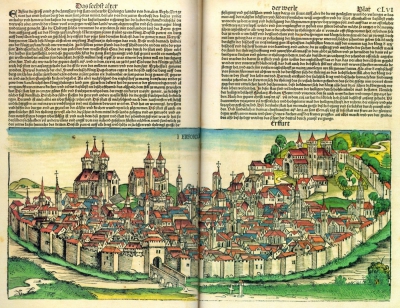The Nuremberg Chronicle is an illustrated encyclopedia consisting of world historical accounts, as well as accounts told through biblical paraphrase. Subjects include human history in relation to the Bible, illustrated mythological creatures, and the histories of important Christian and secular cities from antiquity. Finished in 1493, it was originally written in Latin by Hartmann Schedel, and a German version was translated by Georg Alt. It is one of the best-documented early printed books an incunabulum and one of the first to successfully integrate illustrations and text.
Latin scholars refer to it as Liber Chronicarum (Book of Chronicles) as this phrase appears in the index introduction of the Latin edition. English-speakers have long referred to it as the Nuremberg Chronicle after the city in which it was published. German-speakers refer to it as Die Schedelsche Weltchronik (Schedel's World History) in honour of its author.
Hartmann Schedel (13 February 1440 – 28 November 1514) was a German historian, physician, humanist, and one of the first cartographers to use the printing press. He was born and died in Nuremberg. Matheolus Perusinus served as his tutor.
Schedel is best known for his writing the text for the Nuremberg Chronicle, known as Schedelsche Weltchronik (English: Schedel's World Chronicle), published in 1493 in Nuremberg. It was commissioned by Sebald Schreyer (1446–1520) and Sebastian Kammermeister (1446–1503). Maps in the Chronicle were the first ever illustrations of many cities and countries.
With the invention of the printing press by Johannes Gutenberg in 1447, it became feasible to print books and maps for a larger customer basis. Because they had to be handwritten, books had previously been rare and very expensive.
Schedel was also a notable collector of books, art and old master prints. An album he had bound in 1504, which once contained five engravings by Jacopo de' Barbari, provides important evidence for dating de' Barbari's work.

1493Jul, 12
Hartmann Schedel's Nuremberg Chronicle, one of the best-documented early printed books, is published.
Choose Another Date
Events on 1493
- 15Feb
Columbus's letter on the first voyage
While on board the Niña, Christopher Columbus writes an open letter (widely distributed upon his return to Portugal) describing his discoveries and the unexpected items he came across in the New World. - 4Mar
Voyages of Christopher Columbus
Explorer Christopher Columbus arrives back in Lisbon, Portugal, aboard his ship Niña from his voyage to what is now The Bahamas and other islands in the Caribbean. - 4May
New World
Pope Alexander VI divides the New World between Spain and Portugal along the Line of Demarcation. - 3Nov
Dominica
Christopher Columbus first sights the island of Dominica in the Caribbean Sea. - 18Nov
Puerto Rico
Christopher Columbus first sights the island now known as Puerto Rico.

 English
English  español
español  français
français  português
português  русский
русский  العربية
العربية  简体中文
简体中文 